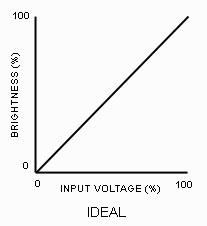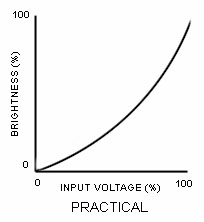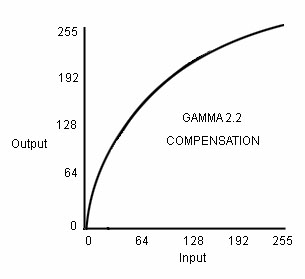To assess the gamma for your monitor, view the scale below from a distance greater than arm's length. Half close your eyes so that the black numbers appear blurred, and then select the grey square which merges the most effectively into its background. A Windows PC monitor typically exhibits a gamma of about 2.2, and that of a Macintosh computer usually approximates to 1.8.

The term gamma has strong association with the era of cathode-ray tubes televisions, and consequently has a long history. Essentially it represents the error between an ideal linear voltage mapping of a monitor, and the displayed brightness. A monitor's brightness is related to the voltage applied to the relevant circuitry, and would ideally be directly proportional to it as shown in the graph on the right. If this were the case, the monitor's gamma would be 1. However, practical monitors do not perform in an ideal linear fashion.  Displayed brightness tends to drop below the linear relationship in the mid-ranges of voltage and brightness, as shown in the graph below, so a correction must be applied. Images captured by digital cameras are consequently encoded with a gamma compensation for the darkening effect of computer monitors. The gamma function is applied using a particular gamma value and the images themselves, or the files in which their data is stored, are then described as having an inherent gamma value. It is worth noting that they are therefore not linear.
Displayed brightness tends to drop below the linear relationship in the mid-ranges of voltage and brightness, as shown in the graph below, so a correction must be applied. Images captured by digital cameras are consequently encoded with a gamma compensation for the darkening effect of computer monitors. The gamma function is applied using a particular gamma value and the images themselves, or the files in which their data is stored, are then described as having an inherent gamma value. It is worth noting that they are therefore not linear.
 Monitors typically have a native gamma of about 2.5, but the human eye does not necessarily want a linear response. Linear images may appear flat and rather uninteresting, so additional gamma adjustment is preferable because it brightens the images presented to us. The sRGB standard used for web applications is designed to provide the experience of a gamma of 2.2, so the monitor profile typically applies a small correction of about 1.1. Since the scale is logarithmic, gamma values in a workflow can be multiplied. For example, in the typical gamma 2.2 monitor mentioned above, (gamma 2.2) x (gamma correction 1.1) = gamma 2.5 (approximately). Gamma values are normally quoted as reciprocals for convenience. So a gamma of 1/2.2 is normally just quoted as 2.2, which can be confusing. Note that when gamma is less than 1 (for example 1/2.2, or 0.45) the image gets lighter. When gamma is greater than 1 the image becomes darker.
Monitors typically have a native gamma of about 2.5, but the human eye does not necessarily want a linear response. Linear images may appear flat and rather uninteresting, so additional gamma adjustment is preferable because it brightens the images presented to us. The sRGB standard used for web applications is designed to provide the experience of a gamma of 2.2, so the monitor profile typically applies a small correction of about 1.1. Since the scale is logarithmic, gamma values in a workflow can be multiplied. For example, in the typical gamma 2.2 monitor mentioned above, (gamma 2.2) x (gamma correction 1.1) = gamma 2.5 (approximately). Gamma values are normally quoted as reciprocals for convenience. So a gamma of 1/2.2 is normally just quoted as 2.2, which can be confusing. Note that when gamma is less than 1 (for example 1/2.2, or 0.45) the image gets lighter. When gamma is greater than 1 the image becomes darker.
The values are obtained from the equation Output = Input gamma using the real gamma values such as 1/2.2 or 0.454 as opposed to the greater-than-one reciprocals. For example, for a typical monitor, Output = Input 1/2.2. The table below shows the eight-bit RGB values (R=G=B) output by an ideal linear monitor, and those for a typical practical gamma of 2.2 (0.454). The values in the grey column are calculated, for example using the mid-range value of 128 (0.5), by Output = 0.5 1/2.2 (or 0.5 (0.454) = 0.729. When this is multiplied by 255 to obtain the RGB value, the product is 186 which is the value used for the grey square in the gamma 2.2 check box at the top of the page.
|
Input |
Normalized Input (= Output 1/2.2) |
Output for Gamma = 2.2 |
R = G = B values (= Output x 255) |
Linear Output |
|
0 |
0 |
0 |
0 |
0 |
|
64 |
0.25 |
0.533 |
136 |
64 |
|
128 |
0.5 |
0.729 |
186 |
128 |
|
192 |
0.75 |
0.877 |
224 |
192 |
|
255 |
1 |
1 |
255 |
255 |
Input is now plotted against the gamma 2.2 output in the graph below. This is basically the correction for the native practical monitor characteristic show above. The product of the two characteristics produces a simple image-processing system which is said to be gamma-corrected if the result is linear. This is generally not the case although the overall system function is brought closer to linearity than would have been the case had no gamma compensation been applied.
 When Photoshop is installed on a computer, the setup procedure also installs Adobe Gamma in the control panel (Start - Settings - Control Panel in Windows). This facility can be used to achieve basic calibration of a monitor or to adjust its gamma. It also builds a custom ICC profile for the monitor that the operating system's colour management system (CMS) that can use to replace the default profile installed with the operating system or monitor. The Adobe Gamma profile is likely to prove much more accurate than the standard offering which merely reflects the engineering specification for the monitor.
When Photoshop is installed on a computer, the setup procedure also installs Adobe Gamma in the control panel (Start - Settings - Control Panel in Windows). This facility can be used to achieve basic calibration of a monitor or to adjust its gamma. It also builds a custom ICC profile for the monitor that the operating system's colour management system (CMS) that can use to replace the default profile installed with the operating system or monitor. The Adobe Gamma profile is likely to prove much more accurate than the standard offering which merely reflects the engineering specification for the monitor.






